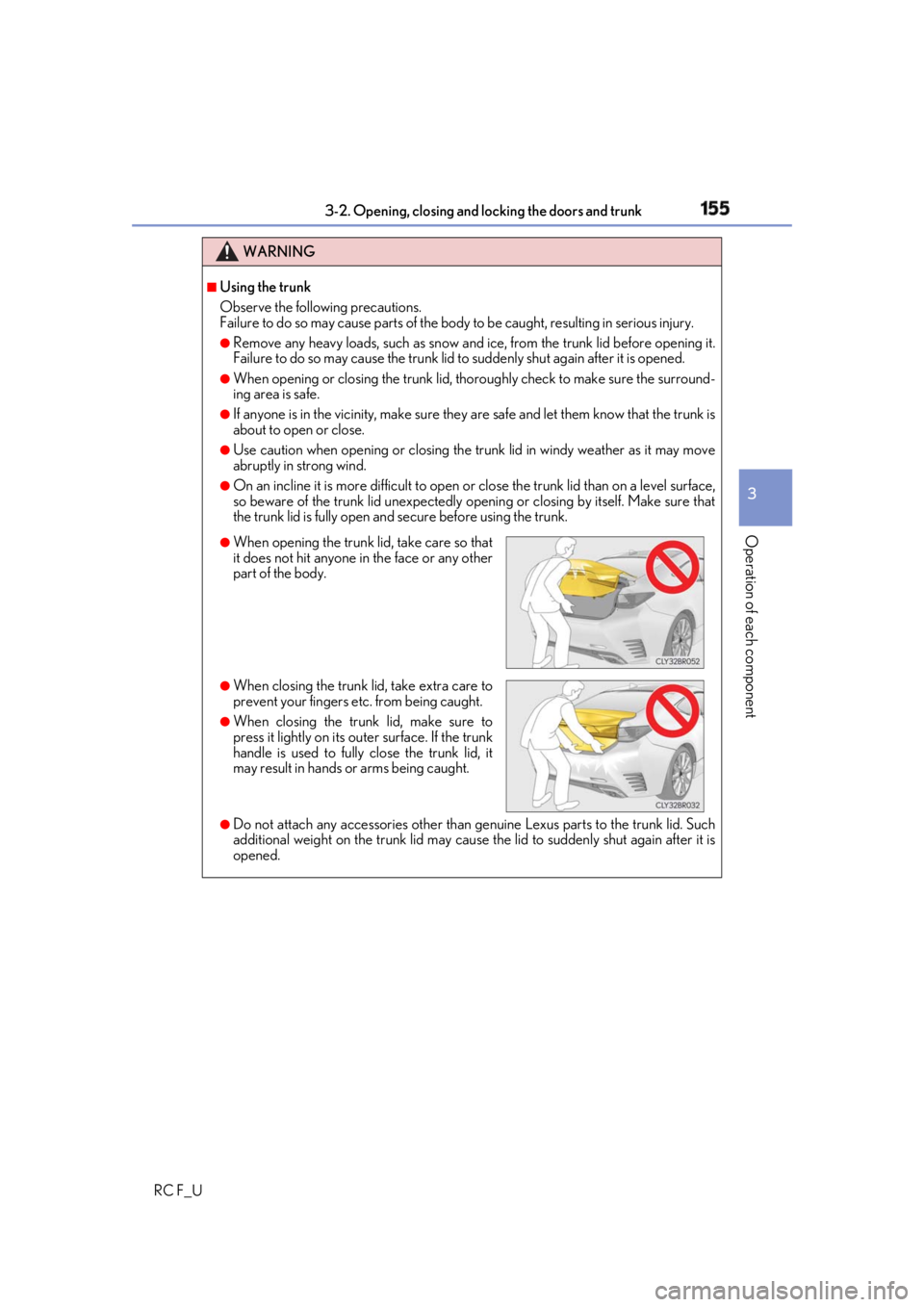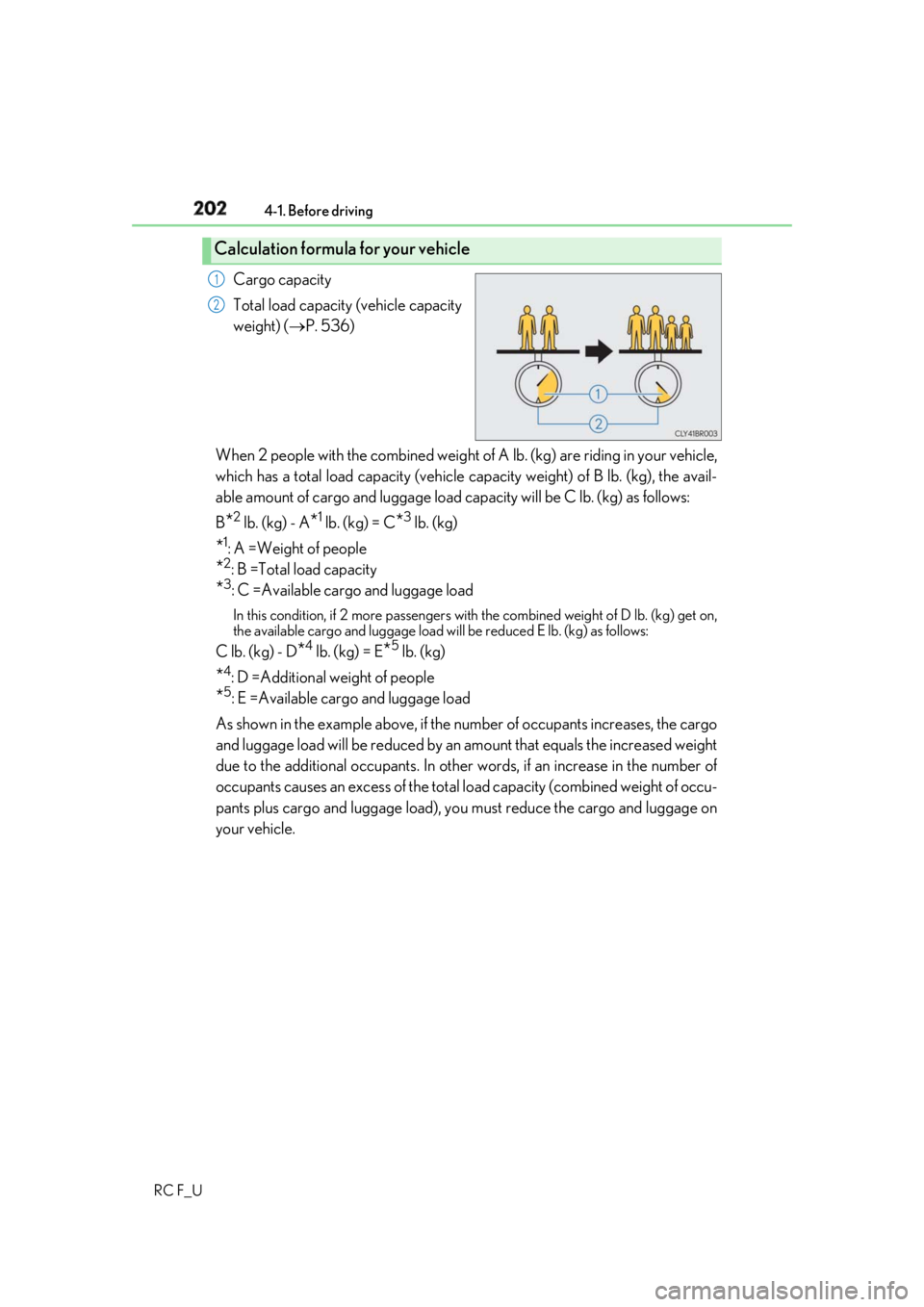weight LEXUS RCF 2019 Owners Manual
[x] Cancel search | Manufacturer: LEXUS, Model Year: 2019, Model line: RCF, Model: LEXUS RCF 2019Pages: 636, PDF Size: 12.48 MB
Page 38 of 636

38 1-1. For safe use
RC F_U WARNING ■
People suffering illness
Obtain medical advice and wear the seat belt in the proper way. ( P. 34)■
When children are in the vehicle
Do not allow children to play with the seat belt. If the seat belt becomes twisted around
a child’s neck, it may lead to choking or othe r serious injuries that could result in death.
If this occurs and the buckle cannot be unfastened, scissors should be used to cut the
belt. ■
Seat belt pretensioners ●
Do not place anything, such as a cushion, on the front passenger’s seat. Doing so will
disperse the passenger’s weight, which prevents the sensor from detecting the pas-
senger’s weight properly. As a result, the seat belt pretensioner for the front passen-
ger’s seat may not activate in the event of a collision. ●
If the pretensioner has activated, the SRS wa rning light will come on. In that case, the
seat belt cannot be used again and must be replaced at your Lexus dealer. ■
Seat belt damage and wear ●
Do not damage the seat belts by allowing th e belt, plate, or buckle to be jammed in
the door. ●
Inspect the seat belt system periodically. Check for cuts, fraying, and loose parts. Do
not use a damaged seat belt until it is replaced. Damaged seat belts cannot protect an
occupant from death or serious injury. ●
Ensure that the belt and plate are locked and the belt is not twisted.
If the seat belt does not function correct ly, immediately contact your Lexus dealer.●
Replace the seat assembly, incl uding the belts, if your vehi cle has been involved in a
serious accident, even if there is no obvious damage. ●
Do not attempt to install, remove, modify, disassemble or dispose of the seat belts.
Have any necessary repairs carried out by your Lexus dealer. Inappropriate handling
may lead to inco rrect operation.■
When using the seat belt guide ●
Always make sure that the belt is not tw isted, and runs freely through the guide.●
Regardless of whether the guide is used or not, always secure the seat belt guide but-
ton. ●
Do not hang from or pull the guide forcefully.
Page 45 of 636

451-1. For safe use
1
For safety and security
RC F_U WARNING ■
SRS airbag precautions ●
Do not hang coat hangers or hard objects on the coat hooks. All of these items could
become projectiles and may cause death or serious injury, should the SRS curtain
shield airbags deploy. ●
If a vinyl cover is put on the area where the SRS knee airbag will deploy, be sure to
remove it. ●
Do not use seat accessories which cover th e parts where the SRS side airbags inflate
as they may interfere with inflation of th e airbags. Such accessories may prevent the
side airbags from activating correctly, disable the system or cause the side airbags to
inflate accidentally, resulting in death or serious injury.●
Do not strike or apply signif icant levels of force to the area of the SRS airbag compo-
nents.
Doing so can cause the SRS airbags to malfunction. ●
Do not touch any of the component part s immediately after the SRS airbags have
deployed (inflated) as they may be hot. ●
If breathing becomes difficult after the SR S airbags have deployed, open a door or
window to allow fresh air in, or leave the vehicl e if it is safe to do so. Wash off any resi-
due as soon as possible to prevent skin irritation. ●
If the areas where the SRS airbags are stored, such as the steering wheel pad and
front and rear pillar garnishes, are damaged or cracked, have them replaced by your
Lexus dealer. ●
Do not place anything, such as a cushion, on the front passenger's seat. Doing so will
disperse the passenger's weight, which prevents the sensor from detecting the pas-
senger's weight properly. As a result, the SRS front airbags for the front passenger
may not deploy in the event of a collision.
Page 55 of 636

551-1. For safe use
1
For safety and security
RC F_U WARNING ■
Front passenger occupant classification system precautions
Observe the following precau tions regarding the front passenger occupant classifica-
tion system.
Failure to do so may cause death or serious injury. ●
Wear the seat belt properly. ●
Make sure the front passenger’s seat belt plate has not been left inserted into the
buckle before someone sits in the front passenger seat.●
Make sure the “AIR BAG OFF” indicator li ght is not illuminated when using the seat
belt extender for the front passenger seat. If the “AIR BAG OFF” indicator light is illu-
minated, disconnect the extender tongue from the seat belt buckle, and reconnect
the seat belt. Reconnect the seat belt extender after making sure the “AIR BAG ON”
indicator light is illuminated. If you use the seat belt extender while the “AIR BAG
OFF” indicator light is illuminated, the SRS airbags for the front passenger may not
activate, which could cause death or seri ous injury in the event of a collision.●
Do not apply a heavy load to the front pa ssenger seat or equipment (e.g. seatback
pocket). ●
Do not put weight on the front passenger seat by putting your hands or feet on the
front passenger seat seatback from the rear passenger seat.●
Do not let a rear passenger lift the front passenger seat with their feet or press on the
seatback with their legs. ●
Do not put objects under the front passenger seat.
Page 155 of 636

1553-2. Opening, closing and locking the doors and trunk
3
Operation of each component
RC F_U WARNING ■
Using the trunk
Observe the following precautions.
Failure to do so may cause parts of the body to be caught, resulting in serious injury.●
Remove any heavy loads, such as snow and ice, from the trunk lid before opening it.
Failure to do so may cause the trunk lid to suddenly shut again after it is opened.●
When opening or closing the trunk lid, thoroughly check to make sure the surround-
ing area is safe. ●
If anyone is in the vicinity, make sure they are safe and let them know that the trunk is
about to open or close. ●
Use caution when opening or closing the tr unk lid in windy weather as it may move
abruptly in strong wind. ●
On an incline it is more difficult to open or close the trunk lid th an on a level surface,
so beware of the trunk lid un expectedly opening or closin g by itself. Make sure that
the trunk lid is fully open and secure before using the trunk.
●
Do not attach any accessories other than genuine Lexus parts to the trunk lid. Such
additional weight on the trunk lid may cause the lid to suddenly shut again after it is
opened. ●
When opening the trunk lid, take care so that
it does not hit anyone in the face or any other
part of the body.
●
When closing the trunk li d, take extra care to
prevent your fingers etc. from being caught. ●
When closing the trunk lid, make sure to
press it lightly on its outer surface. If the trunk
handle is used to fully close the trunk lid, it
may result in hands or arms being caught.
Page 201 of 636

2014-1. Before driving
4
Driving
RC F_U Cargo capacity depends on the total weight of the occupants.
(Cargo capacity) = (Total load capac ity) — (Total weight of occupants)
Steps for Determining Correct Load Limit —
(1) Locate the statement “The combined weight of occupants and cargo should
never exceed XXX kg or XXX lbs. ” on your vehicle’s placard.
(2) Determine the combined weight of th e driver and passengers that will be rid-
ing in your vehicle.
(3) Subtract the combined weight of th e driver and passengers from XXX kg or
XXX lbs.
(4) The resulting figure equals the ava ilable amount of cargo and luggage load
capacity.
For example, if the “XXX” amount equals 1400 lbs. and there will be five 150
lb passengers in your vehicle, the amou nt of available cargo and luggage load
capacity is 650 lbs. (1400 750 (5 150) = 650 lbs.)
(5) Determine the combined weight of luggage and cargo being loaded on the
vehicle. That weight may not safely exceed the available cargo and luggage
load capacity calculated in Step 4.
(6) If your vehicle will be towing a trailer, load from your tra iler will be transferred
to your vehicle. Consult this manual to determine how this reduces the avail-
able cargo and luggage load capacity of your vehicle.
( P. 204)Lexus does not recommend towing a trailer with your vehicle. Your vehicle is not
designed for trailer towing.Cargo and luggage Take notice of the following informat ion about storage precautions, cargo
capacity and load:
Capacity and distribution
Page 202 of 636

202 4-1. Before driving
RC F_U Cargo capacity
Total load capacity (vehicle capacity
weight) ( P. 536)
When 2 people with the combined weight of A lb. (kg) are riding in your vehicle,
which has a total load capacity (vehicle capacity weight) of B lb. (kg), the avail-
able amount of cargo and luggage load capacity will be C lb. (kg) as follows:
B
* 2
lb. (kg) - A
* 1
lb. (kg) = C
* 3
lb. (kg)
* 1
: A =Weight of people
* 2
: B =Total load capacity
* 3
: C =Available cargo and luggage load In this condition, if 2 more passengers with the combined weight of D lb. (kg) get on,
the available cargo and luggage load w ill be reduced E lb. (kg) as follows:
C lb. (kg) - D
* 4
lb. (kg) = E
* 5
lb. (kg)
* 4
: D =Additional weight of people
* 5
: E =Available cargo and luggage load
As shown in the example above, if the nu mber of occupants increases, the cargo
and luggage load will be reduced by an amount that equals the increased weight
due to the additional occupants. In other words, if an increa se in the number of
occupants causes an excess of the total load capacity (combined weight of occu-
pants plus cargo and luggage load), yo u must reduce the cargo and luggage on
your vehicle. Calculation formula for your vehicle 1
2
Page 203 of 636

2034-1. Before driving
4
Driving
RC F_U WARNING ■
Things that must not be carried in the trunk
The following things may cause a fire if loaded in the trunk: ●
Receptacles containing gasoline ●
Aerosol cans ■
Storage precautions
Observe the following precautions.
Failure to do so may prevent the pedals from being depressed properly, may block the
driver’s vision, or may result in items hittin g the driver or passeng ers, possibly causing
an accident. ●
Stow cargo and lugg age in the trunk whenever possible.●
RC350/RC300: To prevent cargo and luggage from sliding forward during braking,
do not stack anything in the enlarged trun k. Keep cargo and luggage low, as close to
the floor as possible. ●
RC350/RC300: When you fold down the rear seats, long items should not be
placed directly behind the front seats. ●
RC350/RC300: Never allow anyone to ride in the enlarged trunk. It is not designed
for passengers. They should ride in their se ats with their seat belts properly fastened.●
Do not place cargo or luggage in or on the following locations.
• At the feet of the driver
• On the front passenger or re ar seats (when stacking items)
• On the package tray
• On the instrument panel
•On the dashboard
• In front of the Center Display ●
Secure all items in the occupant compartment. ■
Capacity and distribution ●
Do not exceed the maximum axle weight rating or the total vehicle weight rating. ●
Even if the total load of occupant’s weight and the cargo load is less than the total load
capacity, do not apply the load unevenly. Improper loading may cause deterioration
of steering or braking control whic h may cause death or serious injury.
Page 204 of 636

204 4-1. Before driving
RC F_U ◆ Total load capacity (vehicle capacity weight): ( P. 536)
Total load capacity means the combined weight of occupants, cargo and lug-
gage.
◆ Seating capacity: 4 occupants (Front 2, Rear 2)
Seating capacity means the maximum number of occupants whose estimated
average weight is 150 lb. (68 kg) per person.
◆ Towing capacity
Lexus does not recommend towing a trailer with your vehicle.
◆ Cargo capacity
Cargo capacity may increase or decrease depending on the weight and the
number of occupants. ■
Total load capacity and seating capacity
These details are also described on the tire and loading information label. ( P. 420)Vehicle load limits Vehicle load limits include total load capacity, seating capacity, towing capac-
ity and cargo capacity.
WARNING ■
Overloading the vehicle
Do not overload the vehicle.
It may not only cause damage to the tires, but also degrade steering and braking ability,
resulting in an accident.
Page 416 of 636

416 6-3. Do-it-yourself maintenance
RC F_U ■
Maximum load of tire
Check that the maximum load of the replacement tire is greater than 1/2 of the Gross
Axle Weight Ratings (GAWR) of either the front axle or the rear axle, whichever is
greater.
■
Tire types ●
Summer tires
Summer tires are high-speed performance ti res best suited to highway driving under
dry conditions. Since summer tires do not have the same traction performance as
snow tires, summer tires are inadequate for driving on snow-covered or icy roads. For
driving on snow-covered roads or icy road s, the use of snow tires is recommended.
When installing snow tires, be sure to replace all four tires.●
All season tires
All season tires are designed to provide better traction in snow and to be adequate for
driving in most winter conditions as well as for use year-round. All season tires, how-
ever, do not have adequate traction perfor mance compared with snow tires in heavy
or loose snow. Also, all season tires fall short in acceleration and handling perfor-
mance compared with summer tires in highway driving.●
Snow tires
For driving on snow-covered roads or icy roads, we recommend using snow tires. If
you need snow tires, select ti res of the same size, construction and load capacity as the
originally installed tires. Since your vehicle has radial tires as or iginal equipment, make
sure your snow tires also have radial cons truction. Do not install studded tires without
first checking local regulations for possible restrictions. Snow tires should be installed
on all wheels. ( P. 320)■
If the tread on snow tires wears down below 0.16 in. (4 mm)
The effectiveness of the tire s as snow tires is lost.For the GAWR, see the Ce rtification Label. For
the maximum load of the tire, see the load limit
at maximum cold tire inflation pressure men-
tioned on the sidewall of the tire. ( P. 557)
Page 422 of 636

422 6-3. Do-it-yourself maintenance
RC F_U ■
Instructions for checking tire inflation pressure
When checking tire in flation pressure, ob serve the following:●
Check only when the tires are cold.
If your vehicle has been parked for at least 3 hours or has not been driven for more than
1 mile or 1.5 km, you will get an accurate cold tire inflation pressure reading. ●
Always use a tire pressure gauge.
It is difficult to judge if a tire is properly inflated based only on its appearance. ●
It is normal for the tire inflat ion pressure to be higher after driving as heat is generated
in the tire. Do not reduce tire inflation pressure after driving.●
Never exceed the vehicle capacity weight.
Passengers and luggage weight should be placed so that the vehicle is balanced.
WARNING ■
Proper inflation is critical to save tire performance
Keep your tires properly inflated.
If the tires are not properly inflated, the following conditions may occur which could
lead to an accident resultin g in death or serious injury:●
Excessive wear ●
Uneven wear ●
Poor handling ●
Possibility of blowouts resu lting from overheated tires●
Air leaking from between tire and wheel ●
Wheel deformation and/or tire damage ●
Greater possibility of tire damage while driving (due to road hazards, expansion
joints, sharp edges in the road, etc.)
NOTICE ■
When inspecting and adjust ing tire inflation pressure
Be sure to put the tire valve caps back on.
If a valve cap is not installed, dirt or moisture may get into the valve and cause an air
leak, resulting in decreased tire inflation pressure.